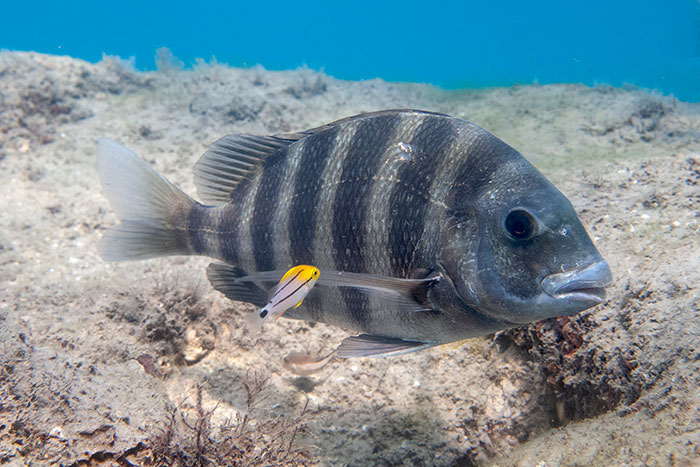
Keeping the Clients Happy
Cleaning behavior by fishes is a phenomenon in which an individual of one species (the “cleaner”) removes annoying external parasites (ectoparasites) as well as mucus, dead skin, and other material from the body surfaces of another species (the “client”). Cleaning behavior occurs in a variety of environmental settings including freshwater, but it is best documented on coral reefs.
The behavior provides a textbook example of a mutualistic relationship in which both parties benefit from an interaction—the cleaner gets an easy meal, and the client is relieved of tormenting ectoparasites. Of course, it is more complicated than this, but I won’t delve into the details for this short blog.
The life work of some species is the removal of ectoparasites from infested clients. These dedicated cleaners are represented by wrasses of the genus Labroides in the Indo-Pacific (Photo 1) and gobies of the genus Elacatinus in the western Atlantic and Eastern Pacific (Photo 2).
 Cleaner gobies Elacatinus genie on a tiger grouper Mycteroperca tigris in Grand Turk, Turks and Caicos Islands.Dedicated cleaners set up stations on the reef where clients can enjoy swim-through servicing. Depending on the reef type and geographic location, visitors to cleaning stations range from small damselfishes to huge manta rays. Although clients are relieved of ectoparasites, which are mostly tiny crustaceans (think bed bugs, lice, or ticks), their attraction to cleaning stations may be additionally motivated by tactile stimulation provided by the cleaner—yes, it is essentially a massage to some species.
Cleaner gobies Elacatinus genie on a tiger grouper Mycteroperca tigris in Grand Turk, Turks and Caicos Islands.Dedicated cleaners set up stations on the reef where clients can enjoy swim-through servicing. Depending on the reef type and geographic location, visitors to cleaning stations range from small damselfishes to huge manta rays. Although clients are relieved of ectoparasites, which are mostly tiny crustaceans (think bed bugs, lice, or ticks), their attraction to cleaning stations may be additionally motivated by tactile stimulation provided by the cleaner—yes, it is essentially a massage to some species.
It is highly entertaining to watch a Labroides cleaning station on an Indo-Pacific reef as a welter of itchy clients jostle for their time in the “booth”. Some clients wait patiently, signaling their readiness to the cleaner by changing color or posture, whereas other individuals may barge in, interrupting the process like a rude shopper at a Black Friday sale.
Some clients slip into a trance-like state as the cleaner (“masseuse”) works up and down their bodies. I once watched a large male hogfish (Lachnolaimus maximus) slowly rotate like a pinwheel 360 degrees vertically as a group of cleaner gobies (Elacatinus genie) worked him over on a Bahamian Reef. Such observations are common and generally support the tactile stimulation theory. Occasionally the cleaner will hit a tender spot, causing the client to flinch or beat a hasty retreat.
There is be pact of sorts between cleaners and clients that overturn normal predator-prey relationships. It’s not unusual to see cleaner wrasses or gobies regularly enter the gaping mouths of predatory groupers (Family Epinephelidae) and moray eels (Family Muraenidae) to engage in a little dental hygiene. In return for their services, cleaner fishes seem to gain immunity from fish-eating predators.
 Juvenile porkfish Anisotremus virginicus cleaning a sheepshead (Archosargus probatocephalus) in Lake Worth Lagoon, Florida.
Juvenile porkfish Anisotremus virginicus cleaning a sheepshead (Archosargus probatocephalus) in Lake Worth Lagoon, Florida.
Cleaning does not end with the dedicated species. Individuals of non-cleaning species (usually conspicuously colored, younger stages) will grab the occasional fish louse when it’s easy and convenient. These facultative cleaners include members of the wrasse (Labridae), angelfish (Pomacanthidae), porgy (Sparidae), jack (Carangidae), drum (Sciaenidae), and grunt (Haemulidae) families. This facultative cleaning is exemplified by the porkfish (Anisotremus virginicus) on nearshore reefs in Florida (Photo 3). Some individuals will establish a cleaning station on a reef or wreck and invite clients in for a grooming. The same reef may support dozens or more juvenile porkfish, but only a few individuals seem to engage in the cleaning behavior.
There is much to be learned here as with facultative cleaning behavior in general. I have always been intrigued by facultative cleaning by juvenile stage individuals and will likely return to this topic in future posts.
- Dave Snyder
Corporate Headquarters
8502 SW Kansas Ave.
Stuart, FL 34997

